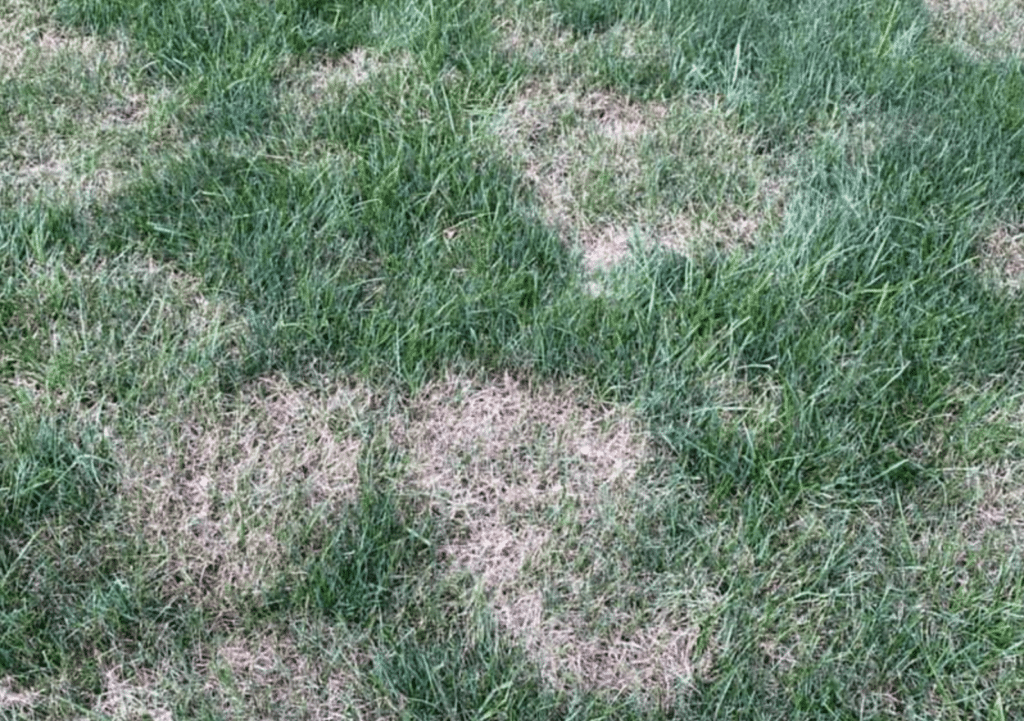LAWN PHIX PRO TIPS
Summer Patch is often mistaken for other lawn diseases – particularly Brown Patch. It shares many characteristics including being a root disease that is most prevalent during hot, wet summer weather. Initial damage appears as small straw-colored circles gradually expanding over a few weeks. Grass on the circle’s edge can turn orange or bronze. To diagnose it as Summer Patch, check the crowns and roots, which will be brown or black since it’s a root disease. I’ve found the best remedy is prevention (cultural practices, incorporating turf nutrition, and rotating fungicides). To control active Summer Patch disease, I prefer Azoxystrobin as the patches first begin to appear. Delaying treatment for a week or two can lead to substantial damage.
Summer patch disease is a fungal infection that affects grass blades as well as turfgrass roots of many lawn types, including Kentucky bluegrass, annual bluegrass, and fine fescues. A particularly destructive lawn disease, summer patch may invade a lawn’s root system in spring but not cause symptoms until the hot weather of summer. Here, we’ll discuss this lawn disease in detail, including the symptoms of summer patch and how to treat it with lawn fungicide and preventative tips.
Table of Contents
What Is Summer Patch?
Summer patch is a lawn disease that is caused by the fungus Magnaporthe poae. The disease is characterized by irregular circular patches that may grow up to 12 inches in diameter. Summer patch symptoms include straw-colored patches, wilted turf, and a frog eye effect that is sometimes noted in the middle of a brown patch where turf stand may resist the infection. These crescents and half-moons are different than brown patch fungus which are usually full circles, and dollar spot that starts out as much smaller silver dollars.
Summer patch disease affects the root system of infected grasses – particularly Poa species (bluegrasses) and fine fescue – preventing it from delivering nutrients and water to grass blades. The disease tends to thrive on lawns where soil temperatures are above 65 degrees Fahrenheit. Generally, creeping bentgrass and perennial ryegrass (PRG) are resistant and not affected by summer patch.
What Causes Summer Patch Fungus?
The fungus that causes summer patch disease thrives in hot weather; though, it can remain inactive during the rest of the year, including winter. Infected plant debris can introduce the fungus to lawns where it can erupt in its telltale patches once conditions are conducive to its growth. Short lawns are especially vulnerable to summer patch, particularly if they’re suffering from drought stress and the weather is hot–above 90 degrees Fahrenheit, and soil temperatures between 65-70 degrees Fahrenheit. Heat stress, soil compaction, frequent (but not deep) irrigation, and nutrient deficiencies can also leave grass vulnerable to this lawn disease.



Summer Patch Treatment
To treat summer patch, you’ll want to make sure you’ve diagnosed it properly. Some people may mistake this lawn disease for brown patch or dollar spot disease. You can pull up some of the turf to examine its root growth; summer patch development affects root tissue, so rotting roots are a hallmark of this disease. Lawn fungicide products such as Azoxystrobin and/or Propiconazole are effective for helping to control the disease when it’s in its active stage. Fungicide applications should be rotated and introduced in accordance with label directions. Apply preventative rates in the spring, and curative applications to your turf as soon as symptoms appear. However, fungicides alone may not eradicate the problem for your grass. It’s important to perform other measures when caring for your lawn, including:
- Apply nitrogen fertilizer
- Mow at the correct height for your grass type
- Correct soil compaction and poor drainage
- Reduce thatch
Also, remember that watering turf deeply but infrequently can help you combat and even prevent summer patch. Planting summer patch-resistant grasses can also help you maintain a healthy green lawn.
Can I Prevent Summer Patch?
You may be able to prevent summer patch from affecting the root development of your lawn by performing some of the steps we mentioned above. Some of the measures you can take to protect root tissue from this infection include:
- Reduce soil compaction
- Reduce thatch
- Provide infrequent watering (but watering deeply to ensure water penetrates the soil surface)
- Maintain a healthy lawn
- Improve wet soil conditions
- Overseed with a blend of resistant grasses, including perennial ryegrass
Mowing your lawn too short leaves turf vulnerable to summer patch eruptions, so be sure to mow it at the proper length. Use a sharp lawnmower blade for a clean-cut, reducing the tearing of the leaf tip which can lead to fungal activity.
Summer Patch FAQs
What causes summer patch disease?
Summer patch is caused by a fungus that thrives in hot conditions, especially during late summer. It causes the roots of grass to rot. The fungus causes tan brown patches to appear on the affected areas of turf. As the small patches grow, they may feature a reddish color.
How do I stop summer patch disease?
Preventing summer patch is typically easier than treating this grass disease. To combat the disease, be sure to water your lawn deeply but infrequently, do not mow it too short, correct problems like poor drainage, and prevent thatch buildup. When symptoms of the disease appear, introduce fungicide applications to your turf. You should always apply them in accordance with label directions.
What are the best fungicides for summer patch grass disease?
To treat summer patch root disease, opt for fungicides like Azoxystrobin and/or Propiconazole. They are highly effective for combatting this fungal lawn infection.
